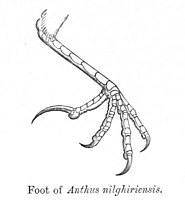Nilgiri pipit
 From Wikipedia - Reading time: 7 min
From Wikipedia - Reading time: 7 min
| Nilgiri pipit | |
|---|---|

| |
| Scientific classification | |
| Domain: | Eukaryota |
| Kingdom: | Animalia |
| Phylum: | Chordata |
| Class: | Aves |
| Order: | Passeriformes |
| Family: | Motacillidae |
| Genus: | Anthus |
| Species: | A. nilghiriensis
|
| Binomial name | |
| Anthus nilghiriensis Sharpe, 1885
| |
The Nilgiri pipit (Anthus nilghiriensis) is a distinctive species of pipit that is endemic to the high altitude hills of southern India. Richer brown in colour than other pipits in the region, it is distinctive in having the streaking on the breast continuing along the flanks. It is non-migratory and has a tendency to fly into low trees when disturbed and is closely related to the tree pipits Anthus hodgsoni and Anthus trivialis.
Description
[edit]The Nilgiri pipit is about 12.6–14 centimetres (5.0–5.5 in) long and is richly coloured, has dark lores, a buff supercilium and throat. It lacks any malar stripes. The flanks, breast and sides of neck are brighter buff and that bill is completely dark. The crown is heavily streaked in black as are the upperparts. The outer tail feathers are also buff coloured and there is no white in the plumage. The streaking on the breast is fine and it extends along the flanks.[2][3][4]
The first four primaries of the wing are almost equal and the fifth is about 1–2 mm shorter. The primaries from the second to the fifth are emarginate. The tail feathers are pointed and the second outer feather has a tapering triangle along the shaft and the third with a small triangle at the tip.[5] Abnormal albino individuals have been reported.[6]
-
The streaking extends along the flanks
-
The hind claw is stout and curved
Taxonomy
[edit]
| |||||||||||||||
| Phylogeny of living relatives[7] |
The species was first described by Jerdon in 1840 under the name of Anthus rufescens, a name already used by Temminck for a different species. Blyth referred to it under the name of Anthus montanus. These are however invalid names and it was redescribed under replacement name of A. nilghiriensis by Richard Bowdler Sharpe in 1885.[8]
The Nilgiri pipit is closely related to the tree pipits and is a sister to the clade containing Anthus trivialis and Anthus hodgsoni from which it diverged in the Pliocene.[7]
Distribution and habitat
[edit]
The Nilgiri pipit is closely associated with short montane grasslands interspersed with marshy grounds and small streams mostly in hill slopes above 1,000 metres (3,300 ft) in the Ponmudi hills and above 1,500 metres (4,900 ft) in the Nilgiris, Palani and High Ranges.[5] They have also been claimed to occur in the Kalakkad Mundanthurai Tiger Reserve[9] but a 2014 study suggests that the species is restricted to the high altitude grassy peaks of the Nilgiris and the Anamalais. Museum specimens exist from the Palani ranges but habitat changes may have led to its reduction or extirpation as the species was not found in surveys in the 21st century.[10]
Behaviour
[edit]Nilgiri pipits are found singly or in pairs. When disturbed they usually fly into a low bush or tree.[2] They breed in summer from April to July. The nest is a cup of grass in short grass. The clutch consists of two to three grey brown speckled eggs.[5] They feed on grass seeds and insects with invertebrates becoming more important during the breeding season.[1]
Status
[edit]The world population is estimated to be about 4000 birds based on a density estimate of about 0.1 birds per hectare in suitable habitat. The grassland habitat is threatened by wattle plantations and the colonization of grasslands by species such as broom (Cytisus scoparius) in the Nilgiris and by fire.[1][11][12]
References
[edit]- ^ a b c BirdLife International (2016). "Anthus nilghiriensis". IUCN Red List of Threatened Species. 2016: e.T22718582A94586848. doi:10.2305/IUCN.UK.2016-3.RLTS.T22718582A94586848.en. Retrieved 12 November 2021.
- ^ a b Rasmussen PC & JC Anderton (2005). Birds of South Asia. The Ripley Guide. Volume 2. Washington DC & Barcelona: Smithsonian Institution and Lynx Edicions. pp. 321–322.
- ^ Hall, BP (1961). "The taxonomy and identification of pipits (genus. Anthus)". Bull. Br. Mus. (Nat. Hist.). 7: 243–289.
- ^ Oates, EW (1890). The Fauna of British India. Birds. Volume 2. London: Taylor and Francis. p. 305.
- ^ a b c Ali, S & SD Ripley (1998). Handbook of the birds of India and Pakistan. Volume 9 (2nd ed.). Oxford University Press. pp. 271–273.
- ^ Beadnell, CB (1936). "An albino Nilgiri Pipit (Anthus nilghiriensis Sharpe)". J. Bombay Nat. Hist. Soc. 39 (1): 174.
- ^ a b Alstrom, P.; Jonsson, K. A.; Fjeldsa, J.; Odeen, A.; Ericson, P. G. P.; Irestedt, M. (2015). "Dramatic niche shifts and morphological change in two insular bird species". Royal Society Open Science. 2 (3): 140364. Bibcode:2015RSOS....240364A. doi:10.1098/rsos.140364. PMC 4448822. PMID 26064613.
- ^ Sharpe, R.B. (1885). Catalogue of the Passeriformes, or perching birds, in the collection of the British Museum. Fringilliformes. Part 1. pp. 550–551.
- ^ Johnsingh A.J.T. (2001). "The Kalakad–Mundanthurai Tiger Reserve: A global heritage of biological diversity" (PDF). Current Science. 80 (3): 378–388.
- ^ Robin, V.V.; C.K.Vishnudas & Uma Ramakrishnan (2014). "Reassessment of the distribution and threat status of the Western Ghats endemic bird, Nilgiri Pipit Anthus nilghiriensis" (PDF). Current Science. 107 (4): 622–630.
- ^ Anonymous (1998). SACON annual report. SACON, Coimbatore. p. 23.
- ^ Zarri, A. A.; A. R. Rahmani & M. J. Behan (2006). "Habitat modifications by scotch broom Cytisus scoparius invasion of grasslands of the upper Nilgiris in India". Journal of the Bombay Natural History Society. 103: 356–365.
 KSF
KSF

